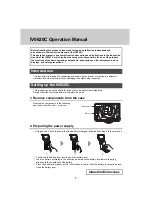
6-19
IM 760201-01E
Harmonic Measurement (Optional)
3
2
1
4
5
6
7
8
9
10
11
12
13
14
App
Index
Setting the Bar Graph Display Range
• The bar graph display range is set in terms of harmonic orders.
• The display ranges of Graph1 to Graph3 are the same.
• The minimum harmonic order is 0 (DC). However, if the measurement function is set
to
f
,
f
U, or
f
I, the 0
th
order has no value. Thus, the 0
th
order is not displayed in the
bar graph.
• If the measurement function is set to
f
U or
f
I, the 1
st
order has no value. Thus, the 1
st
order is not displayed in the bar graph.
• The maximum settable harmonic order is 50. However, bar graphs of orders that
exceed the upper limit of harmonic analysis (see section 6.4 for details) are not
displayed.
Cursor Measurement
• ON/OFF
A cursor can be placed on the displayed bar graph to measure the value at that point.
• ON: Cursor measurement is performed.
• OFF: Cursor measurement is not performed.
• Measured Items
• Y1+: Y-axis value of of bar graph 1
• Y1x: Y-axis value of cursor x of bar graph 1
•
Δ
Y1: Difference between the Y-axis values of and cursor x of bar graph 1
• Y2+: Y-axis value of of bar graph 2
• Y2x: Y-axis value of cursor x of bar graph 2
•
Δ
Y2: Difference between the Y-axis values of and cursor x of bar graph 2
• Y3+: Y-axis value of of bar graph 3
• Y3x: Y-axis value of cursor x of bar graph 3
•
Δ
Y3: Difference between the Y-axis values of and cursor x of bar graph 3
• Moving the Cursors
• Two cursors (+ and x) are displayed in each graph (Graph1 to Graph3).
• The cursor positions are set by harmonic order.
• The bar graph display indicates what harmonic order each cursor is located in. For
example:
• The location of is indicated in this format: “order+:2.”
• The location of cursor x is indicated in this format: “orderx:45.”
• C and x are located in the same harmonic orders in each graph (Graph1 to
Graph3).
Note
If immeasurable data exists, “***” is displayed in the measured value display area.
6.7 Displaying Bar Graphs and Making Cursor Measurements
















































